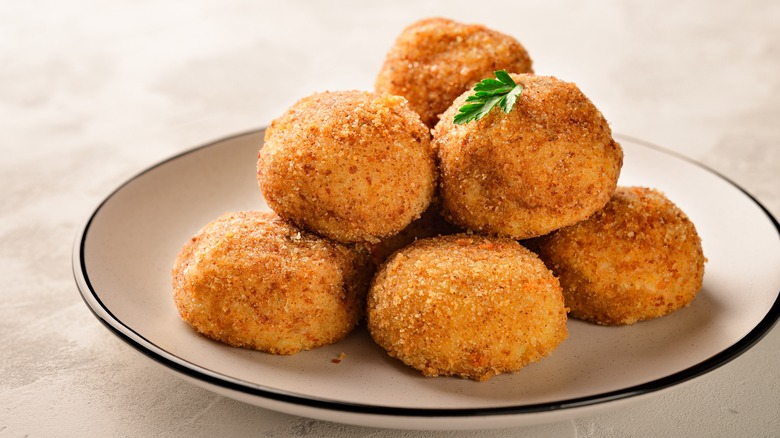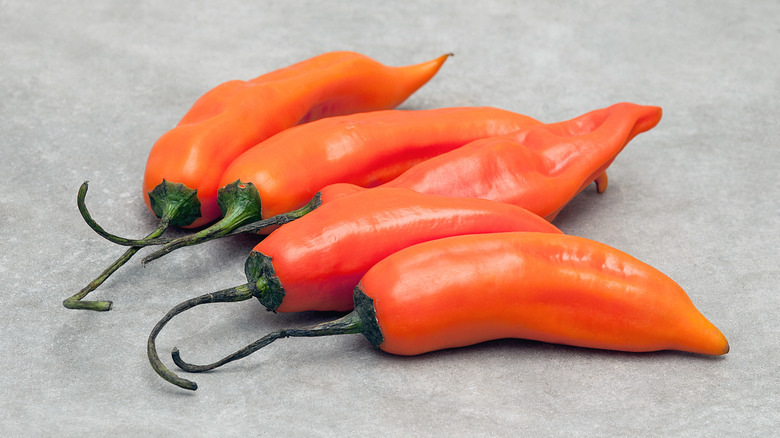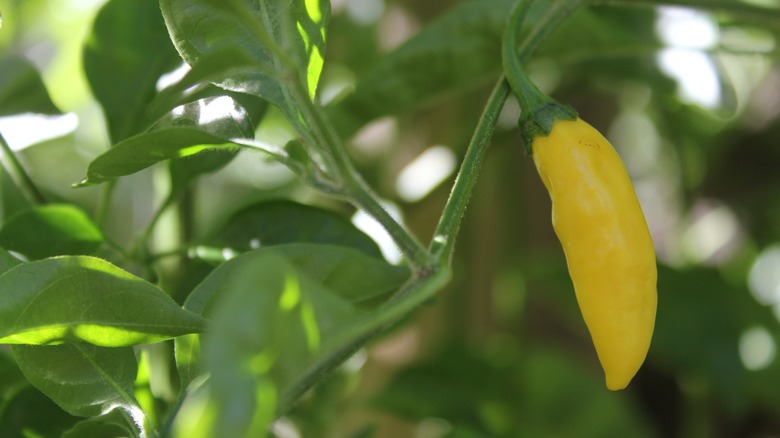The Key Ingredient You Need For Traditional Peruvian Stuffed Potatoes
Papa rellena is one of the most iconic dishes in Peruvian cuisine, its popularity extending through Bolivia, Colombia, and Puerto Rico, and much of the rest of Latin America, where it's known as rellenos de papa. The name translates as "stuffed potato," and they fuse an idel combination — beef and potatoes — into a single, glorious bite.
Essentially a potato croquette, papa rellena consists of a spiced beef filling packed into a mashed potato shell and deep-fried to a golden crisp. Raisins, olives, and chopped hard-boiled eggs are common additions to the filling. Though recipes may vary, they all stay true to the beef-and-potato formula, as well as the spice that leads the flavor profile: aji pepper.
There are multiple varieties of aji chile peppers, but the best-known is aji amarillo, named for its color, which changes from a light yellow to a bright orange as the plant ages. In its most common form, the pepper is boiled and made into a paste, which can be jarred or canned for long-term storage (and long-distance shipping). Most recipes involving aji amarillo use this paste, but its raw and powdered forms are quite popular as well.
As far as ingredients go, few are as unsubstitutable as aji amarillo. You cannot substitute anything for it — no other pepper brings this particular flavor profile — and without it, papa rellana, and most Peruvian dishes for that matter, simply aren't complete.
What makes aji amarillo peppers special?
The aji amarillo chile has a proud history in Peru. It is believed that they were first grown by Inca farmers around 2500 B.C., and they have been synonymous with Andean cuisine ever since. Gastón Acurio, perhaps the most famous contemporary chef in Peru, has touted the peppers as the most important ingredient in Peruvian cuisine, while Michelin-starred chef Virgilio Martínez told The Telegraph in 2014 that aji amarillo is "the DNA of Peruvian cuisine."
Aji amarillo lend a spicy kick, but are not overwhelmingly hot. It ranges from 30,000-50,000 on the Scoville chile heat scale, which makes it about as spicy as a cayenne pepper. However, its impact on flavor profiles goes far beyond heat. This is a flavorful, fruity pepper, imparting subtle hints of mango and papaya to every dish in which it is featured. It doesn't taste like any other pepper, in no small part because it belongs to the Capsicum baccatum family, one of the rarest in its genus.
This chile pepper is a popular addition to ceviche, a component of iconic Peruvian dishes like aji de gallina, causa rellena, and papa a la huacina, and the base of a vast variety of sauces. It is considered one of the "Holy Trinity" of Peruvian cooking, the other two being garlic and red onion. The powdered version is frequently included in spice rubs.
Other varieties of aji pepper
Aji amarillo may be the best-known aji pepper, but it isn't the only one. Other varieties are much harder to come by, but to a true chile pepper enthusiast, they could be worth tracking down. After aji amarillo, the most popular variety in Peru is aji panca. It is dark red and has a smoky flavor that's milder than aji amarillo. Aji panca is particularly popular in marinades for grilled meats called "anticuchos".
There is an incredible degree of variance when it comes to the spice levels of aji peppers. On the one hand, you have aji cito. Reaching up to 100,000 Scoville units, it is the hottest of all aji peppers. On the other hand, there's aji dulce, which maxes out at 1,000 Scoville units, and drops as low as zero. The flavor profile is sweet with smoky notes. Aji dulce is particularly popular in the Caribbean, being prominent in Cuban, Puerto Rican, and Dominican cuisines.
One of, if not the, most remarkable varieties of aji chile pepper is aji limon, also known as the lemon drop pepper. It truly lives up to its name, with a distinct citrus flavor, the intensity of which can range from fresh lemon to more subtle lemongrass. It's also as eye-catching as a chile pepper can be, with a brilliant yellow hue that even outshines aji amarillo. It's a bit milder than aji amarillo, ranging from 15,000-30,000 Scoville units. Substitute it for lemon to add a spicy kick to your food.


